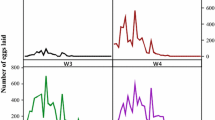Abstract
The life cycle of Ixodes luciae was evaluated for five consecutive generations in the laboratory. Wild mice Calomys callosus and laboratory rats Rattus norvegicus were used as hosts for larvae and nymphs. For adult ticks, opossums Didelphis aurita were used as hosts. Off-host developmental periods were observed in an incubator at 27°C and 95% RH. The life cycle of I. luciae lasted 95–97 days, excluding prefeeding periods. C. callosus, one of the natural host species for I. luciae immature stages, was shown to be much more suitable than the artificial host R. norvegicus. Significantly (P < 0.05), more larvae and nymphs successfully fed on C. callosus than on R. norvegicus. When tick-naïve C. callosus were exposed to three consecutive larval infestations at 24-day intervals, recovery of engorged larvae were greater in the second and third infestations, indicating that previous infestations did not induce acquired resistance to ticks. Larval feeding period typically varied from 5 to 10 days on R. norvegicus, but was significantly (P < 0.05), longer on C. callosus (range, 7–34 days). The majority (71.7%) of I. luciae adult females successfully fed and oviposited after exposed to D. aurita. Mean engorged weight (581.9 mg; range, 237.1–796.0 mg) of these females were much higher than those previously reported for other New World Ixodes species. Our results are in accordance to the current literature that appoints opossums Didelphidae and small rodents (e.g., C. callosus) natural hosts for I. luciae immature and adult stages, respectively.
Similar content being viewed by others
References
Autino AG, Nava S, Venzal JM, Mangold AJ, Guglielmone AA (2006) La presencia de Ixodes luciae en el noroeste argentino y nuevos huéspedes para Ixodes pararicinus y algunas especies de Amblyomma (Acari: Ixodidae). Rev Soc Entomol Argent 65:27–32
Banks CW, Oliver JH Jr, Phillips JB, Clark KL (1998a) Life cycle of Ixodes minor (Acari: Ixodidae) in the laboratory. J Med Entomol 35:496–499
Banks CW, Oliver JH Jr, Hopla CE, Dotson EM (1998b) Laboratory life cycle of Ixodes woodi (Acari: Ixodidae). J Med Entomol 35:177–179
Barros-Battesti DM, Onofrio VC, Faccini JLH, Labruna MB, Arruda-Santos AD, Giacomin FG (2007) Description of the immature stages and redescription of the female of Ixodes schulzei Aragão & Fonseca, 1951 (Acari: Ixodidae), an endemic tick species of Brazil. Syst Parasit 68:157–166
Bennett GF (1974) Oviposition of Boophilus microplus (Canestrini) (Acarina: Ixodidae). Acarologia 16:1652–1661
Dantas-Torres F, Onofrio VC, Barros-Battesti DM (2009) The ticks (Acari: Ixodida: Argasidae, Ixodidae) of Brazil. Syst Appl Acarol 14:30–46
Faccini JLH, Prata MCA, Daemon E, Barros-Battesti DM (1999) Características biológicas da fase não parasitária do Ixodes amarali (Acari: Ixodidae) em gambá (Didelphis sp.) no Estado do Rio de Janeiro. Arq Bras Med Vet Zootec 51:267–270
Fairchild GB, Kohls GM, Tipton V (1966) The ticks of Panama. In: Wenzel RL, Tipton VJ (eds) Ectoparasites of Panama. Field Museum of Natural History, Chicago, pp 167–219
Fielden LJ, Rechav Y, Bryson NR (1992) Acquired immunity to larvae of Amblyomma marmoreum and A. hebraeum by tortoises, guinea pigs and guinea fowl. Med Vet Entomol 6:251–254
Guglielmone AA, Estrada-Peña A, Keirans JE, Robbins RG (2003) Ticks (Acari: Ixodida) of the Neotropical Zoogeographic Region. International Consortium on Ticks and Tick-borne Diseases, Atalanta, Houten, The Netherlands, 173 pp
Jacobs PAH, Fourie LJ, Horak IG (2004) A laboratory comparison of the life cycles of the dog ticks Haemaphysalis leachi and Rhipicephalus sanguineus. Onderstepoort J Vet Res 71:15–28
Jones EK, Clifford CM, Keirans JE, Kokls GM (1972) The ticks of Venezuela (Acarina: Ixodoidea) with a key to the species of Amblyomma in the Western Hemisphere. Brigham Young Univ Biol Ser Sci Bull Biol Ser 17:1–40
Labruna MB, Leite RC, Faccini JLH, Ferreira F (2000) Life-cycle of Haemaphysalis leporis-palustris (Acari: Ixodidae) under laboratory conditions. Exp Appl Acarol 24:683–694
Labruna MB, Silva MJN, Oliveira MF, Barros-Battesti DM, Keirans JE (2003) New records and laboratory-rearing data for Ixodes schulzei (Acari: Ixodidae) in Brazil. J Med Entomol 40:116–118
Labruna MB, Pinter A, Teixeira RHF (2004) Life cycle of Amblyomma cooperi (Acari: Ixodidae) using capybaras (Hydrochaeris hydrochaeris) as hosts. Exp Appl Acarol 32:79–88
Labruna MB, Camargo LM, Terrassini FA, Ferreira F, Schumaker TTS, Camargo EP (2005) Ticks (Acari: Ixodidae) from the state of Rondonia, western Amazon, Brazil. Syst Appl Acarol 10:17–32
Mónica-Díaz M, Nava S, Venzal JM, Sánchez N, Guglielmone AA (2007) Tick collections from the Peruvian Amazon, with host records for species of Ixodes Latreille, 1795 (Acari: Ixodidae) and Ornithodoros Koch, 1844 (Acari: Ixodidae). Syst Appl Acarol 12:127–133
Nava S, Lareschi M, Beldomenico PM, Zerpa C, Venzal JM, Mangold AJ, Guglielmone AA (2004) Sigmodontinae rodents as hosts for larvae and nymphs of Ixodes loricatus Neumann, 1899 (Acari: Ixodidae). Parasite 11:411–414
Neitz WO, Boughton F, Walters HS (1971) Laboratory investigation on the life cycle of the Karoo Paralysis tick (Ixodes rubicundus Neumann, 1904). Onderstepoort J Vet Res 38:215–224
Pinter A, Dias RA, Gennari SM, Labruna MB (2004) Study of the seasonal dynamics, life cycle, and host specificity of Amblyomma aureolatum (Acari: Ixodidae). J Med Entomol 41:324–332
Randolph SE (1979) Population regulation in ticks: the role of acquired resistance in natural and unnatural hosts. Parasitology 79:141–156
Rechav Y (1992) Naturally acquired resistance to ticks. A global view. Insect Sci Appl 13:495–504
Schumaker TT, Labruna MB, Abel IS, Clerici PT (2000) Life cycle of Ixodes (Ixodes) loricatus (Acari: Ixodidae) under laboratory conditions. J Med Entomol 37:714–720
Yonow T (1995) The life-cycle of Amblyomma variegatum (Acari: Ixodidae): a literature synthesis with a view to modeling. Int J Parasitol 25:1023–1060
Acknowledgements
We thank Pedro Cesar Nogueira da Silva and Thomas Bronhall for technical assistance with animals. This work was supported by Fundação de Amparo a Pesquisa de São Paulo and Conselho Nacional de Desenvolvimento Científico e Tecnológico.
Author information
Authors and Affiliations
Corresponding author
Rights and permissions
About this article
Cite this article
Labruna, M.B., Cabrera, R.R. & Pinter, A. Life cycle of Ixodes luciae (Acari: Ixodidae) in the laboratory. Parasitol Res 105, 1749–1753 (2009). https://doi.org/10.1007/s00436-009-1621-8
Received:
Accepted:
Published:
Issue Date:
DOI: https://doi.org/10.1007/s00436-009-1621-8




